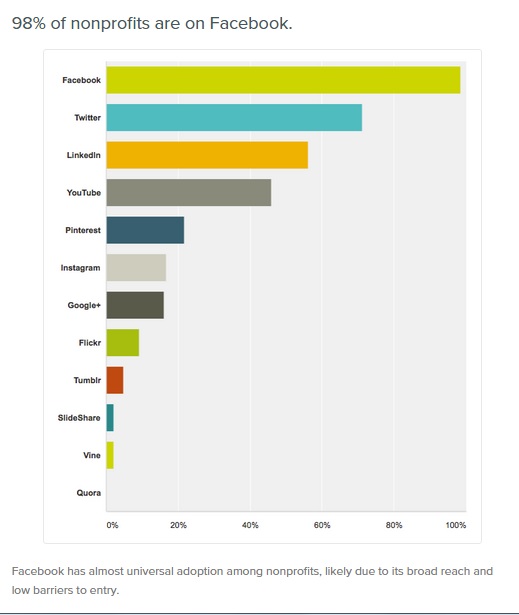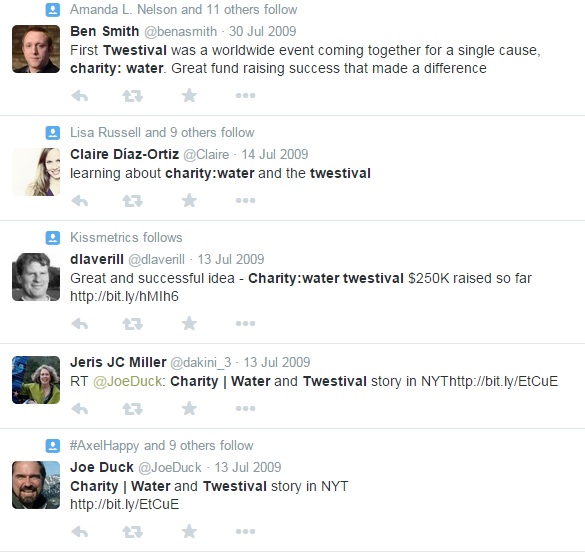Social Media Marketing Guide for Non-profit Organizations
A 2014 survey of 9000 small and medium non-profits by Hubspot revealed that almost all of them found social media to be valuable in their marketing efforts. With an opportunity to reach out to millions of people at a time, social media can be extremely useful in spreading the word about a cause. As a non-profit, you can simultaneously raise awareness of and garner support for your cause through platforms like Facebook and Twitter.
While it’s true that social media can help you create a great impact on your audience, it’s also true that without the know-how you could be left feeling discouraged to use it. Here’s a 3 step guide on how you can leverage the power of social media for your non-profit.
3 simple steps to build a strong social media presence
1. Setting up your accounts
Before you set up an account decide on the platforms you want to use. It’s a good idea to establish your presence on multiple platforms, but be careful not to commit to too many. Evaluate the amount of time and effort you can dedicate to decide on how many accounts you can maintain, without letting them go inactive.
When you set up you’re social media accounts, ensure that your fill out your profiles in their entirety. Using a default profile photo, not adding a link to your website, or not describing your cause are the most basic errors that could cost you dearly. Also, ensure that you set up your accounts as a business, and not as an individual. Accounts for businesses usually come with additional features, such as page analytics that can help track your performance.
2. Building your network and prompting conversations
Add your email contacts to your social accounts to find people you already know. Invite them to follow you. Also request them to share your page with their friends. Make sure to add all your employees too and request them to spread the word through their channels. Search for specific people or keywords and send out invites to those who may be interested in your cause. Also keep an eye on sections like Suggested friends on Facebook and People You May Know on Twitter to add acquaintances to your network.
Alongside building your network, you also have to start posting on your account. When you’re just starting out, it may be especially useful to share posts that talk about things that you’ve done so far and the things that you intend to do in the future. For somebody who isn’t familiar with your work, this information could help get them interested in it. Also, remember to keep your posts visual by sharing as many photos and videos as you can. Find other people and pages that are in the same space as you, and follow them. Like, Share, Retweet or Comment on their posts to start conversations. Being pro-active in social conversations can help you build a bigger network faster.
3. Getting more out of social media
Once you’re familiar with the basics of how a specific platform works, start exploring advanced features. If you have the budget for paid campaigns, spend some time on understanding how social media advertising works. When creating campaigns, be clear about your objectives – are you trying to spread awareness, attract volunteers or get donations? If your website, micro-sites and blogs don’t already have social media buttons, it’s important that you have them added. Also share links to your social accounts on all marketing collaterals, including newsletters, emailers, flyers, and signages.
Use social media automation tools to improve the efficiency of your marketing efforts. For instance, use content curation and scheduling tools like DrumUp to achieve consistency in posting activities. Followerwonk is a good one to use to identify influencers and understand follwer-demographics. BuzzSumo can help you identify trending topics within your niches. IFTTT is a great way to automate mundane tasks such as creating backups on Dropbox, or sharing a post from one of your accounts to another.
3 successful non-profit social media campaigns
Social media messaging is particularly important in the case of non-profits because it plays an important role in how your followers perceive your cause. The 3As (Advocacy, Appeal, and Appreciation) strategy focuses on key elements that can make your messaging more impactful. Several non-profits have been successful in catching the attention of their audience through strong messaging. Here are three examples for inspiration.
Facebook – Earth Hour by the World Wildelife Fund – Advocacy
Earth is a global event organized annually by the World Wildlife Fund (WWF) to encourage people to turn-off non-essential lights for an hour. In 2013, the event was organized by WWF Honk Kong. While the team used multiple platforms to reach out to a wider audience, its Facebook campaign that year was particularly successful. The organizers roped in five national celebrities, giving Facebook users access to their promotional videos after they liked the page. Thanks to the campaign, the conversation volume on the page increased from an average of 3.13% per day to 16.45% per day. Their fanbase increased by 10-fold, and the most popular of the videos logged 27,000 views in just three weeks.
Twitter – Charity:Water – Appeal
Charity:Water is an NGO that drills wells in poverty-stricken communities across the globe. It has been extremely successful in its social media campaigns across platforms, and enjoys an ardent following of millennials. “Twestival” organized by one of its supporters, joined forces with Twitter-users in 200 cities to host a live, online fund-raising event. In 2009, the event received $250,000 in donations, and seeing its success Twitter formalized “Twestivals” to help other non-profits emulate the same model.
Instagram – Pencils of Promise – Appreciation
Thanking donors is a critical element of any fundraiser you organize. Pencils of Promise calls itself a “for-purpose” organization that works to improve access to education in impoverished communities around the world. Their Back-to-School campaign last year received much appreciation for how it used Instagram to keep followers informed of the progress made. Their Thank You posts received several comments including those from people who were moved by them and wanted to make donations too.
Save time managing your social media accounts
Are you still managing your social media accounts directly from Facebook/Twitter/LinkedIn? Make your life easier by managing all your social media in one place, schedule posts, repeat posts, curate content and more. Try DrumUp now, it's free, forever.
45 actionable tips strengthen your social media presence
1. Have at least one person on your team dedicated to manage your social media presence
2. Establish your presence on multiple social media platforms to amplify your reach
3. Use tools to increase the efficiency of your social media activities
4. Word your posts to start conversations, either by asking a question or expressing a concern
5. Check notifications on all your social accounts at regular intervals – 2-3 times a day
6. Respond to all comments and queries
7. Track conversations that mention you
8. Review the performance of your posts
9. Run contests on your social media pages
10. Create recurring posts around a theme, like #ThrowbackThursday
11. Share updates from related pages
12. Share pictures of your team in action
13. Include links to your social profiles in your mailers and newsletters
14. Distribute links to your content (blogs, studies, surveys, reports etc.) through social media
15. Include social sharing buttons on your Sign-up/Donate pages to let supporters spread the message through their channels
16. Include social sharing buttons in your email petitions
17. Put-up posters at on-ground events encouraging attendees to check-in (add image)
18. Conduct polls to gather public opinion on issues related to your cause
19. Run a crowd-funding campaign for small events
20. Connect with journalists who write about your cause
21. Use social media to lobby for or against policy changes relevant to your cause proposed by the government
22. Follow influencers and share their posts
23. Invite influencers to host a discussion on your page or group
24. Request employees to include your Twitter handle in their Bio
25. Discover networking opportunities with your employees’ connections
26. Encourage employees to post about their experience of working with your organization on their personal profiles
27. Share visual content more often
28. Use action-specific landing pages
29. Optimize your social media landing pages for mobile
30. Schedule your posts to ensure consistency in posting activities
31. Interact with related groups on social media and participate in discussions
32. Start groups to encourage discussions around pertinent issues
33. Use platforms like Quora and Reddit to answer questions on how you allocate your funds, or how successful a particular campaign turned out to be
34. Use LinkedIn groups to brainstorm on solutions to common challenges faced by others who support similar causes
35. Use Facebook Causes for individual campaigns
36. Use relevant Hashtags and @mentions in your Tweets
37. Track Twitter Bios to identify people who support your cause and request them to follow you or join your group
38. Use Twitter lists to organize your followers
39. Create a Twitter list of followers who are more responsive and target them more often
40. Track followers in your vicinity and send them special invites to your events
41. Thank your sponsors and donors – @mention them on Twitter; write on their Page on Facebook
42. Encourage volunteers to ideate and execute social media campaigns through their personal profiles
43. Request volunteers to share their experiences on your page
44. Share stories of your volunteers on what inspired them to support your cause
45. @mention your most active volunteers on a weekly, monthly or quarterly basis to express your appreciation of their efforts
We agree that’s an ambitious list, but you don’t have to do it all at once. Start small and let your efforts gain momentum over time.
If you have any other tips to share, leave us a comment below.



